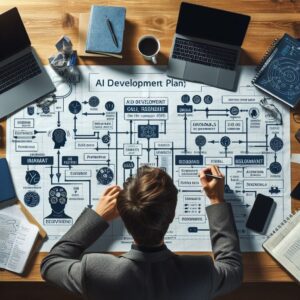Our Quick Guide for Creating Your AI Roadmap
Imagine a future where AI streamlines operations, personalizes customer experiences and unlocks hidden growth opportunities for your business. That future is closer than you think, but navigating the path to AI integration can feel daunting—it requires careful planning, strategic foresight, and a well-defined roadmap.
Consider this startling statistic from Accenture. While 84% of C-level executives acknowledge that scaling AI is vital for their business strategies, only a mere 16% have transitioned from experimental phases to building robust AI capabilities within their organizations. This gap highlights the critical need for businesses to not only recognize the importance of AI but also to implement a structured approach to its integration.
An AI roadmap serves as a guiding framework that outlines the steps, milestones, and strategies necessary to successfully incorporate AI technologies into various aspects of an organization. Whether it’s enhancing customer experiences, optimizing operations, or unlocking new revenue streams, a well-crafted AI roadmap aligns business objectives with AI initiatives, ensuring a focused and effective implementation.
Understanding AI and Its Impact
Artificial intelligence (AI) is revolutionizing how we work and live. But what exactly is it? AI refers to the ability of machines to simulate human intelligence processes like learning, problem-solving, and decision-making. It’s achieved through a variety of technologies, each with its own strengths:
- Machine Learning (ML): This allows machines to learn from data without explicit programming. Imagine a program that analyzes customer reviews to identify buying trends – that’s machine learning in action.
- Deep Learning: This is a subfield of ML inspired by the structure of the human brain. Deep learning algorithms are particularly adept at recognizing patterns in complex data, making them ideal for applications like image and speech recognition.
- Natural Language Processing (NLP): This technology enables machines to understand and process human language. NLP powers chatbots, sentiment analysis tools, and even machine translation services.
Now, let’s explore the potential impact of AI across various industries:
- Healthcare: AI can analyze medical images for faster and more accurate diagnoses, personalize treatment plans, and even assist in drug discovery.
- Finance: AI can automate fraud detection, predict market trends, and manage investment portfolios more efficiently.
- Manufacturing: AI can optimize production lines, predict equipment failures, and improve overall quality control.
- Retail: AI can power personalized recommendations for customers, optimize pricing strategies, and manage inventory levels more effectively.
Laying the Groundwork
Before diving headfirst into AI integration, it’s crucial to assess your organization’s readiness and consider some key preliminary factors.
Here are some questions to help you gauge your organization’s AI readiness:
- Do you have a clear understanding of your business goals and how AI can help achieve them? AI shouldn’t be a technology for technology’s sake. It should be a tool that aligns with your overall business strategy.
- Do you have access to high-quality, well-organized data? AI models are only as good as the data they’re trained on. Dirty or incomplete data will cause unreliable results.
- Do you have the technical expertise or resources to implement and maintain AI solutions? This could involve hiring data scientists, investing in cloud computing infrastructure, or partnering with external AI vendors.
- Do you have a culture of innovation and openness to change within your organization? Implementing AI often requires adapting processes and workflows, so employee buy-in is crucial.
Preliminary Considerations for Successful AI Integration
- Define Your AI Goals: Be specific about what you want to achieve with AI. Do you want to automate tasks, improve decision-making, or develop new products or services?
- Identify the Right AI Use Case: Not all problems require AI solutions. Focus on areas where AI can provide a clear advantage over traditional methods.
- Start Small and Scale Up: Don’t try to implement a company-wide AI overhaul all at once. Begin with a pilot project in a well-defined area and learn from your successes and challenges before scaling up.
- Build a Strong AI Team: This could involve hiring data scientists, AI engineers, and change management specialists, or partnering with external AI expertise.
- Focus on Data Governance: Establish clear policies for data collection, storage, and usage to ensure compliance with regulations and ethical considerations.
- Embrace a Culture of Experimentation: Be prepared to adapt your approach as you learn more about AI and its potential within your organization.
Building Your AI Team
Embarking on an AI project requires more than just technical expertise—it demands a diverse and interdisciplinary team capable of navigating the complexities of artificial intelligence from multiple perspectives.
1. Data Scientists:
- Role: Data scientists form the backbone of AI projects, specializing in extracting insights from data using statistical analysis, machine learning, and data modeling techniques.
- Skills: Proficiency in programming languages (e.g., Python, R), machine learning algorithms, data manipulation, and visualization tools.
- Contribution: They clean, preprocess, and analyze data to train AI models, evaluate model performance, and iterate for improvements.
2. Machine Learning Engineers:
- Role: ML engineers focus on implementing machine learning models into production systems, optimizing for scalability, reliability, and performance.
- Skills: Software engineering, model deployment, cloud computing (e.g., AWS, Azure), and familiarity with ML frameworks (e.g., TensorFlow, PyTorch).
- Contribution: They bridge the gap between data science research and deployment, ensuring AI models function effectively in real-world applications.
3. Domain Experts:
- Role: Domain experts bring industry-specific knowledge and insights crucial for understanding business goals, defining problem statements, and interpreting AI results in context.
- Skills: Deep understanding of the industry, domain-specific data expertise, and the ability to communicate effectively with technical teams.
- Contribution: They guide AI projects by providing domain context, identifying relevant data sources, validating AI outcomes against business objectives, and ensuring ethical considerations are addressed.
4. Data Engineers:
- Role: Data engineers are responsible for building and maintaining data pipelines, ensuring data availability, quality, and accessibility for AI projects.
- Skills: Data wrangling, database management (SQL, NoSQL), ETL (Extract, Transform, Load) processes, and knowledge of big data technologies.
- Contribution: They design scalable data architectures, integrate diverse data sources, and create robust pipelines for data ingestion, transformation, and storage.
5. UX/UI Designers:
- Role: UX/UI designers focus on creating intuitive user interfaces and experiences for AI-powered applications, considering user needs, behaviors, and feedback.
- Skills: User research, prototyping, usability testing, information architecture, and design thinking.
- Contribution: They ensure AI solutions are user-friendly, accessible, and aligned with user expectations, enhancing adoption rates and user satisfaction.
6. Project Managers:
- Role: Project managers oversee AI projects from initiation to delivery, coordinating tasks, managing resources, mitigating risks, and ensuring alignment with stakeholders.
- Skills: Project management methodologies (e.g., Agile, Scrum), communication, stakeholder management, budgeting, and risk assessment.
- Contribution: They maintain project timelines, facilitate collaboration among team members, prioritize tasks, and communicate progress and challenges to stakeholders.
Developing the AI Roadmap
An AI roadmap serves as your GPS, guiding you on your journey toward successful AI integration. Here’s what you need to consider when developing your roadmap:
Setting SMART Goals
- Specific: Clearly define what you want to achieve with AI. Is it to improve customer service response times by 20%? Increase manufacturing efficiency by 10%?
- Measurable: Establish Key Performance Indicators (KPIs) to track your progress. These could be metrics like customer satisfaction scores, production output, or cost reduction figures.
- Attainable: Be realistic about your goals and resources. Don’t set yourself up for failure by aiming for unrealistic outcomes.
- Relevant: Ensure your goals align with your overall business strategy and address a genuine need within your organization.
- Time-bound: Set deadlines for achieving your goals to maintain focus and accountability.
Mapping Your Milestones
Break your AI project into smaller, achievable milestones. This will help you track your progress, identify potential roadblocks, and adjust your course as needed. Some examples of milestones could be:
- Completing a feasibility study and selecting a pilot project.
- Gathering and preparing data for AI model training.
- Deploying a minimum viable product (MVP) of your AI solution.
- Evaluate your pilot project results and iterate your solution.
Choosing the Right AI Tools and Technologies
There’s no single “best” AI technology – the optimal choice depends on your specific needs and goals. Consider factors like:
- The nature of your problem: Is it a classification task (like identifying spam emails) or a prediction task (like forecasting sales figures)?
- The type of data you have available: Text data, image data, sensor data – all require different approaches.
- Your existing infrastructure: Can your current systems handle the computational demands of AI models?
Key Performance Indicators (KPIs)
As mentioned earlier, KPIs are crucial for measuring your progress and ensuring your AI solution delivers real value. These metrics will vary depending on your goals, but some common examples include:
- Accuracy: How well does your AI model perform the task it’s designed for?
- Efficiency: Does AI save time or resources compared to traditional methods?
- Cost Savings: Has AI led to lower operational costs?
- Return on Investment (ROI): Is the value generated by AI outweighing the investment costs?
Navigating AI Ethics and Regulations
As AI becomes more powerful, so too does the need to ensure its development and use are ethical and responsible.
Here are some fundamental principles to guide you towards ethical AI development and use:
- Transparency and Explainability: AI models should be transparent enough to understand how they reach decisions. This helps identify and mitigate potential biases and enables human oversight.
- Fairness and Non-Discrimination: AI systems shouldn’t perpetuate or amplify social biases. Careful data selection and model training are crucial to prevent discriminatory outcomes.
- Privacy and Security: User data privacy must be a top priority. Ensure robust security measures are in place to protect sensitive information used in AI models.
- Accountability: There should be clear lines of accountability for the actions and decisions made by AI systems. Who is responsible if an AI makes a mistake?
- Human Control and Oversight: AI should always be under human control. Humans should be able to override AI decisions and ensure AI systems are used for good.
By following these best practices, you can demonstrate your commitment to ethical and responsible AI:
- Conduct a thorough AI ethics impact assessment: Identify potential risks and biases before deploying AI solutions.
- Establish a clear AI ethics framework: Develop internal policies that define acceptable practices for AI development and use within your organization.
- Promote diversity and inclusion in your AI team: A diverse team will bring a wider range of perspectives to the table, helping mitigate bias.
- Be transparent about your use of AI: Inform users when they are interacting with an AI system and be clear about the limitations of the technology.
- Continuously monitor and improve your AI systems: Regularly assess your AI solutions for potential biases and ethical concerns, and be prepared to iterate and improve them.
Implementation and Integration
Implementing and integrating AI projects into existing systems requires careful planning, robust project management, and strategies to overcome challenges inherent in AI development. Here, we delve into key aspects such as project management approaches, common challenges, and integration strategies essential for successful AI project implementation.
Project Management Approaches
- Agile Methodology: Agile methodologies such as Scrum or Kanban are well-suited for AI projects due to their iterative and collaborative nature. Teams work in sprints, focusing on incremental development, continuous feedback, and adaptability to changing requirements.
- Waterfall Methodology: In certain cases, a more sequential approach like the Waterfall methodology may be suitable for AI projects with well-defined requirements and limited changes expected during development.
- Hybrid Approaches: Combining elements of Agile and Waterfall methodologies can offer flexibility while ensuring structured planning and execution, adapting to project-specific needs.
Overcoming Challenges
- Data Quality and Availability: Ensure data quality through rigorous preprocessing, cleansing, and validation techniques. Collaborate with data engineers to build robust data pipelines and ensure data accessibility for AI model training and testing.
- Model Interpretability and Explainability: Address the interpretability of AI models by employing explainable AI techniques, visualizations, and model auditing methods. This enhances trust, compliance, and understanding of AI-driven decisions.
- Ethical and Bias Considerations: Implement fairness checks, bias detection, and mitigation strategies throughout the AI lifecycle. Engage diverse stakeholders, including ethicists, legal experts, and domain specialists, to assess and address ethical implications.
- Scalability and Performance: Design AI solutions with scalability in mind, leveraging cloud services, distributed computing, and scalable architectures. Conduct performance testing, optimization, and monitoring to ensure efficient and reliable AI operations.
Integration Strategies
- API-Based Integration: Develop APIs (Application Programming Interfaces) for seamless integration of AI models into existing systems, enabling data exchange, real-time predictions, and interoperability with other applications.
- Microservices Architecture: Implement AI functionalities as microservices, allowing modular development, independent scaling, and easy integration with different components of the system.
- Containerization and Orchestration: Use containerization tools like Docker and orchestration platforms like Kubernetes to package, deploy, and manage AI applications consistently across diverse environments, improving portability and scalability.
- Legacy System Integration: Integrate AI capabilities with legacy systems through APIs, middleware, or custom connectors. Conduct compatibility assessments, data mapping, and incremental migration strategies to minimize disruptions.
- Continuous Integration and Deployment (CI/CD): Implement CI/CD pipelines for automated testing, validation, and deployment of AI models, reducing time-to-market and ensuring consistent performance across environments.
Monitoring, Evaluation, and Scaling
Your AI is up and running, but the work isn’t over! Just like any high-performance machine, your AI solution requires ongoing monitoring and evaluation to ensure it continues to deliver value. Here’s how to stay on top of things:
- Become a Performance Detective: Track key metrics aligned with your initial goals (e.g., accuracy for spam filtering, efficiency gains in production). Monitor for data drift, where real-world changes can affect your AI’s performance. Regularly assess potential biases to ensure fairness and mitigate discriminatory outcomes.
- Measure the Impact: Go beyond technical performance and assess the real-world impact of your AI. Did it boost customer satisfaction as planned? Has it led to measurable cost savings? Gather user feedback to understand their experience and identify areas for improvement.
- Scaling Up for Bigger Wins: If your AI is a success story, it’s time to think bigger! Identify opportunities to expand its reach within your organization. Can AI be applied to new departments or solve similar problems in different areas? Ensure your infrastructure can handle the increased workload and consider expanding your AI team to maintain expertise as you scale.
Conclusion
Remember, AI is an ongoing process. Once your solution is live, don’t stop there! Continuously monitor performance, evaluate its impact on your business goals, and gather user feedback. As your AI proves its worth, explore opportunities to scale it up and unlock even greater value within your organization.
At RTS Labs, we’re passionate about helping businesses harness the power of AI. We offer a comprehensive suite of services, from assessing your AI readiness to building and deploying custom AI solutions







